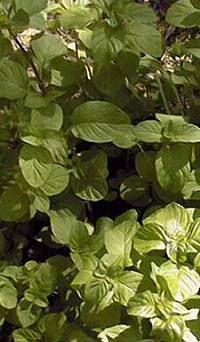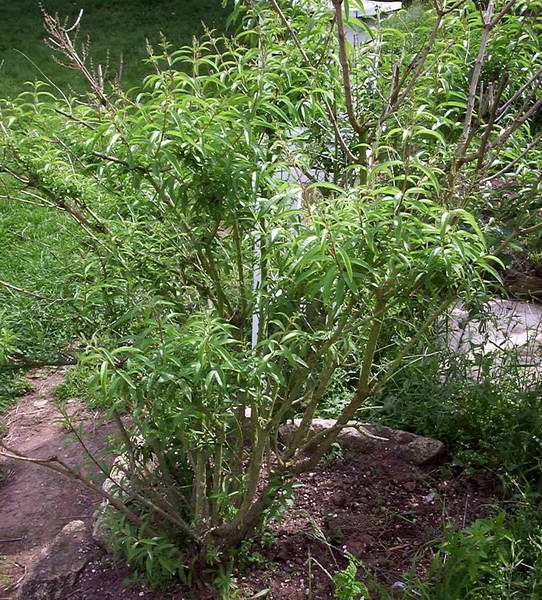When I bought my bottle of The Different Company's perfume called Divine Bergamote, I nearly keeled over from joy because I had finally found, after a twenty year search, what I thought was an authentic Bergamot perfume. This perfume nearly perfectly duplicates those wondrous roots and stems of my favorite garden plant, monarda didyma 'Violet Queen' which in full bloom, seems to attract all the hummingbirds in the entire tri-state area. I love handling this plant, roots, runners, flowers, stems, leaves - everything about it smells delightfully perfumed. But when I tried to research Monardas, I ran into a problem: many plants are called Bee Balm, Balm, or Bergamot; and the local flower nursery called an entirely different, rough-leaved shade plant with ugly sour lemon scented leaves "Balm" or "Verbena." Yet I knew my delicate woody "Verbena" at home was a big bush with toothy, fine, and sweetly lemon-scented leaves.
Wearing Divine Bergamote perfume, and clutching one of my precious dried Lemon Verbena leaves, I found myself researching which perfumes might be made with what bergamots. Are they made with the sweet-earthy-citrus smell of monarda didyma or the wild mountain-grown monarda fistulosa? Or are they made with the sweet citrus-earthy smell of Citrus aurantium Bergamia from Calabria, Italy? The perfume houses appear to be guarding this information to some degree because after extensive research, I can find very few clues as to which is which. And will the real verbena please stand up? Is verbena a plant, or a tree?
I was never able to uncover the bergamots used in perfumes, whether they are monarda didymas or citrus trees from Italy.
However I present to you for your thoughts, a few plant descriptions to get you thinking. I will continue my research -- I swear I will figure out which perfumes contain which balm, bergamot, verbena and bee balm!
Bergamot, aka Citrus aurantium var. bergamia
Oil of Bergamot is drawn from the peel of the Bergamot Orange, aka Citrus aurantium var. bergamia, which is grown in Calabria, Italy for commercial purposes. Bergamot oil from this Calabrian tree is used to flavor Earl Grey tea.Bee Balm, aka Bergamot, aka Monarda fistulosa
Bee Balm, aka Bergamot, aka Monarda didyma
Wild Bergamot (Monarda fistulosa) is often called Bergamot or Bee Balm and there are many forms and cultivars of this flowering plant from the mint family. The cultivated form is known as Mondarda didyma, also known as Oswego Tea or Bee Balm. This herb was originally popular among early American colonists as a tea substitute. The entire plant is fragrant from runner-like roots to square stems to flower petals. Its aromatic fragrance is a result of the chemicals thymol (of which
Monarda didyma is a commercial source) and the oregano-scented carvacrol. Its spicy notes come from eucalyptol and cymeme. Frequently a small flower appears out of the top of the one below - which is a habit of many herbs of the mint family.
A species sold as Lemon Mint is really Western Balm, Monardella odoratissima. Lemon Mint is more of an annual, properly called Monarda citriodora, with pink flowers that have purple spots. It's very rarely available, but also has a strong citrus scent.Bergamot, aka Eau de Cologne mint
Mentha x piperita citrata is variously known as bergamot, Eau de Cologne, or orange mint. The smooth, broad, oval leaves of this small bushy plant have a totally delicious, soothing fragrance, and are good as an infusion for herb tea. This plant has tiny clumps of white flowers and square stems (as with all mints).Lemon Balm, aka Verbena
Lemon Balm, Melissa officinalis, (often called "Balm," "Lemon Balm," "Melissa," or "Verbena"), is a low bushy plant with broad serrated leaves. It contains two lemon-scented chemicals: citral and citronellal. Lemon Balm has been used by generations of beekeepers to entice swarms into their new homes, and once there to remain quietly - knowing how touchy bees can be, the scent must have a soothing quality. Melissa means bee. Balm is a hardy, perennial herb, growing to 36 inches, with crinkly leaves and insignificant white flowers on one side of the square stems.Lemon Verbena
Lemon Verbena, (Lippia citriodora, synonymous with Aloysia triphylla), is usually called "Verbena," or "Lemon scented Verbena." This is a three to five foot tall bush with woody branches, which can be trained into a tree. The bare stems are lemon scented, and the leaves are a heady sweet lemon fragrance that strongly resembles lemon blossoms. This plant is not hardy but can be overwintered indoors in a bright sunny spot. The scent is sharp, sweet, and refreshing, and perfect for potpourri or tea; or dry the leaves and use them as bookmarks. The leaves also freeze in ice cubes and make perfect additions to iced tea. The chemical contributions from its oil to flavor and scent include hydrosol, citral, myrcene and citronellal.





